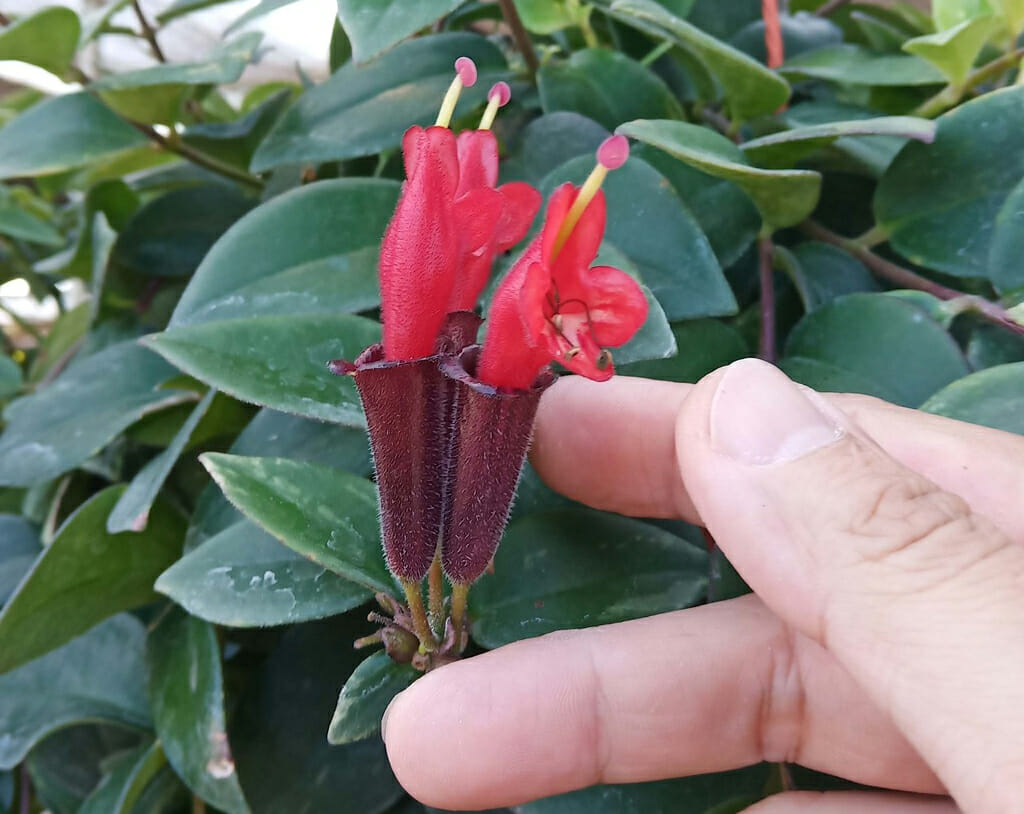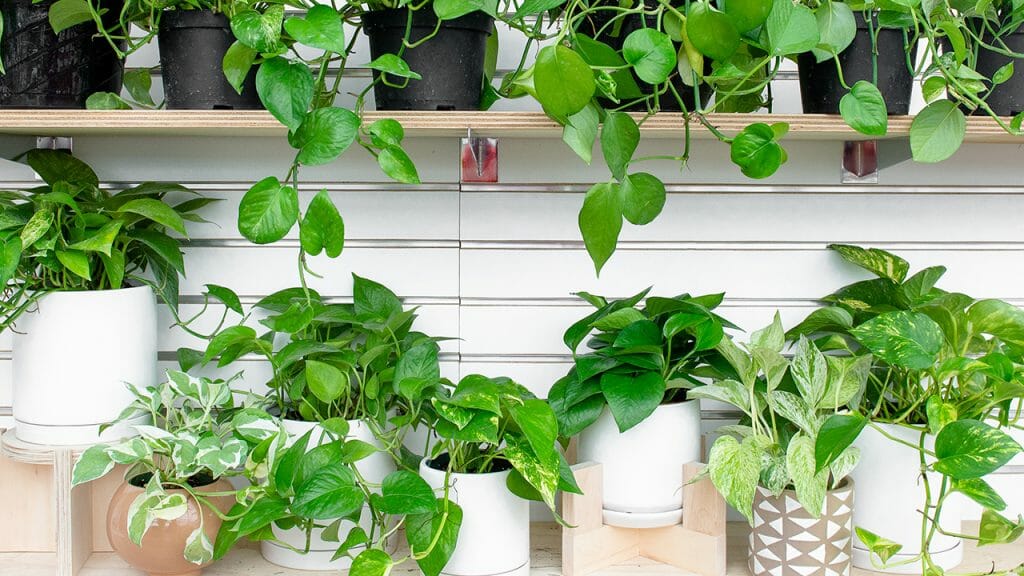
Taking care of a lipstick plant requires careful attention. These tropical houseplants do best in more humid conditions with temperatures between 75°F – 85°F, lots of indirect sunlight and watering whenever the top quarter of the soil dries out.
Lipstick plants are somewhat tedious as they are not the most resistant flowering plants. However, if you give it enough care it will reward you with unique red flowers, several times a year.
Read through our care guide for lipstick plants and find out everything you need to know to enjoy those gorgeous flowers.
What Is a Lipstick Plant?
A lipstick plant, or Aeschynanthus radicans, is a tropical flowering plant that can be kept as an indoor plant. These plants prefer humid conditions above 70 degrees Fahrenheit so, in temperate and cold climates they are only suitable as indoor plants.
Its name is inspired by its bright, often red, cylindrical flowers, somewhat similar to a lipstick tube. Lipstick plants are popular as hanging plants because of their pointed oval-shaped trailing leaves.
Different Types of Lipstick Plant
There are hundreds of different varieties of lipstick plants. The following are the most common species.
- Aeschynanthus radicans Mona Lisa: bright red flowers, green teardrop trailing leaves. A good bloomer.
- Aeschynanthus radicans Krakau: red flowers with darker green leaves
- Aeschynanthus radicans Rasta: red flowers with twisted vines
- Aeschynanthus radicans Curly: red flowers with smaller leaves curling inwards
- Aeschynanthus radicans Tangerine: orangey-yellow flowers
- Aeschynanthus radicans Variegata: orangey-red flowers with white streaking through green leaves
- Aeschynanthus Purple Star: red flowers with purple specks
- Aeschynanthus Cassiopeia: deep purple buds instead of the maroon buds
Lipstick Plant Care Guide
Found your favorite lipstick plant? This is everything you need to know to take good care of your lipstick plant and get it to bloom with flowers.
Sunlight
These tropical plants love lots of indirect sunlight so place it near a window. Lipstick plants won’t produce flowers if they do not get enough sunlight.
Water
Despite enjoying humid conditions, lipstick plants don’t do well in overly moist soil. This means you have to be careful not to overwater it.
It is best to wait until the top 1/4 of the potting soil has dried out before watering it again. In warmer seasons, watering may be required once a week while in colder seasons once every 2 – 3 weeks might be enough.
Soil & Nutrients
Drainage and aeration are very important for lipstick plant soil. Ideally, the soil is a combination of equal parts potting soil, peat and compost or potting mix.
Alternatively, use a premixed soil mix with slow-release fertilizer already included. Also, make sure that the soil is not too heavy and that there are drainage holes for excess water.
Humidity
High humidity is good for lipstick plants. Although they prefer a more dry soil, the leaves and flowers enjoy a little spritz of water every once in a while.
You can also choose to place them in naturally more humid rooms like the kitchen or bathroom. Just make sure that there is enough sunlight reaching the plants in this room.
Temperature
This tropical Asian plant cannot handle cold temperatures. Ideally, the room temperature never drops below 70 degrees Fahrenheit and stays within a cozy range of 75 – 85 degrees Fahrenheit.
Lipstick plants may survive a few hours of colder temperatures but don’t leave them in a cold room during the winter. In the colder months, move the lipstick plant to generally warmer room like the living room.
Pruning
As trailing plants, it is not necessary to prune lipstick plants but you may choose to do so for aesthetic purposes. The best time to prune a lipstick plant is after they have bloomed because the flowers tend to grow at the tip of the leaves.
Common Issues with Lipstick Plants
Although lipstick plants are not prone to diseases, they do require quite specific care. Water levels and humidity are very important and can easily affect the beauty of the houseplant.
Below are examples of potential diseases and signs of poor health in a lipstick plant.
Botrytis
Botrytis appears as black spots. It is a fungus that grows on damaged plant tissue which is more common on fruit and flowering plants.
As long as your lipstick plant doesn’t suffer any damage, it should be safe from botrytis (however botrytis can be harmful to humans). However botrytis, like all fungus, thrives in humid conditions so keep a close eye on your lipstick. Humidity is good for this houseplant but too much humidity is risky.
Losing Leaves or Flowers
If your lipstick plant is losing leaves or flowers, there is probably an issue with how much water it is receiving. Falling leaves and flowers is and indication that the lipstick plant is not receiving enough water and that the soil is dried out.
Make sure to water your lipstick plant whenever the top quarter of the soil has dried out. Remember that it will need more water during warmer weather and less water in the colder months.
Yellowing
Yellowing leaves on a lipstick is often caused by lack of water or lack of sunlight. Check the soil and make sure that it doesn’t dry out more than just the top quarter before watering again.
If the soil is not the problem, the houseplant may want more sunlight. In that case, place it in a spot that gets plenty of indirect light from a window or give it few hours outside for a few days.
Pests
Thankfully, lipstick plants are not prone to pests but there is always the possibility. Pests like fungus gnats, spider mites, mealy bugs and aphids are more common in newly introduced plants. It is always a good idea to isolate new plants for a few weeks before placing it near other houseplants.
If you do notice any of these tiny plant pests, it is important to take action quickly before the population spreads. Neem oil is a popular natural solution for plant pests but there may also be specific chemical solutions for each pest.
Safe Repotting
The roots of lipstick plants do not grow very fast so there is rarely a need for repotting. However, if your lipstick plant has been flourishing for years and outgrown its pot, you do need to give it a bigger home.
The best time to repot a lipstick plant is after it has bloomed. In the right conditions, lipstick plants can bloom several times a year so you will likely have plenty of opportunity.
Here is a quick overview of the steps for repotting a lipstick plant houseplant.
- Fill up the new pot with fertile soil, either premixed or store-bought. Fill it up to approximately a quarter of the plant pot to give the lipstick plant space to grow.
- Take the lipstick plant out of its old pot and clear away some of the soil so that you can inspect the roots.
- Detangle any roots that have started twisting into each other but do so carefully to not cause any damage.
- While still holding the plant, place it inside the new pot to see how much soil is needed so that the stem sticks out of the soil at the same height as in the old pot. Add more soil if the current level is too low.
- Drench the soil in water so you can pack it in better.
- Place the lipstick plant in its new plant pot and add the necessary soil.
- Water the soil again to check the drainage and press down on the top layer.
Frequently Asked Questions:
Why Are the Leaves Falling Off My Lipstick Plant?
Falling leaves on a lipstick plant are usually a sign of dehydration. It is sign that your plant needs to be watered more frequently.
Do Lipstick Plants Need Sun?
Lipstick plants, like almost all plants, need sun to survive and bloom flowers. However, it prefers indirect sunlight. Ideally, lipstick plants are placed near windows but not in a spot that gets full sunlight throughout the day.
How Do I Get My Lipstick Plant to Flower?
Lipstick plants can bloom throughout the year in ideal conditions. However, it is more common for them to bloom during the warmer months in spring and summer.
If your lipstick plant is not producing flowers, try placing it in a spot with more sunlight and keep a close eye on the moisture level of the soil.
Summary
Since lipstick plants have specific environmental preferences, it may require careful observation to find the ideal spot in the house for them. Even then, you have to be mindful of when to water them, how to give it more or less humidity and how its needs change throughout the year.
Lipstick plants are not the best houseplants for beginners but they are a very rewarding challenge. If you want to test your green thumb, any of the Aeschynanthus radicans are a fun plant project.


